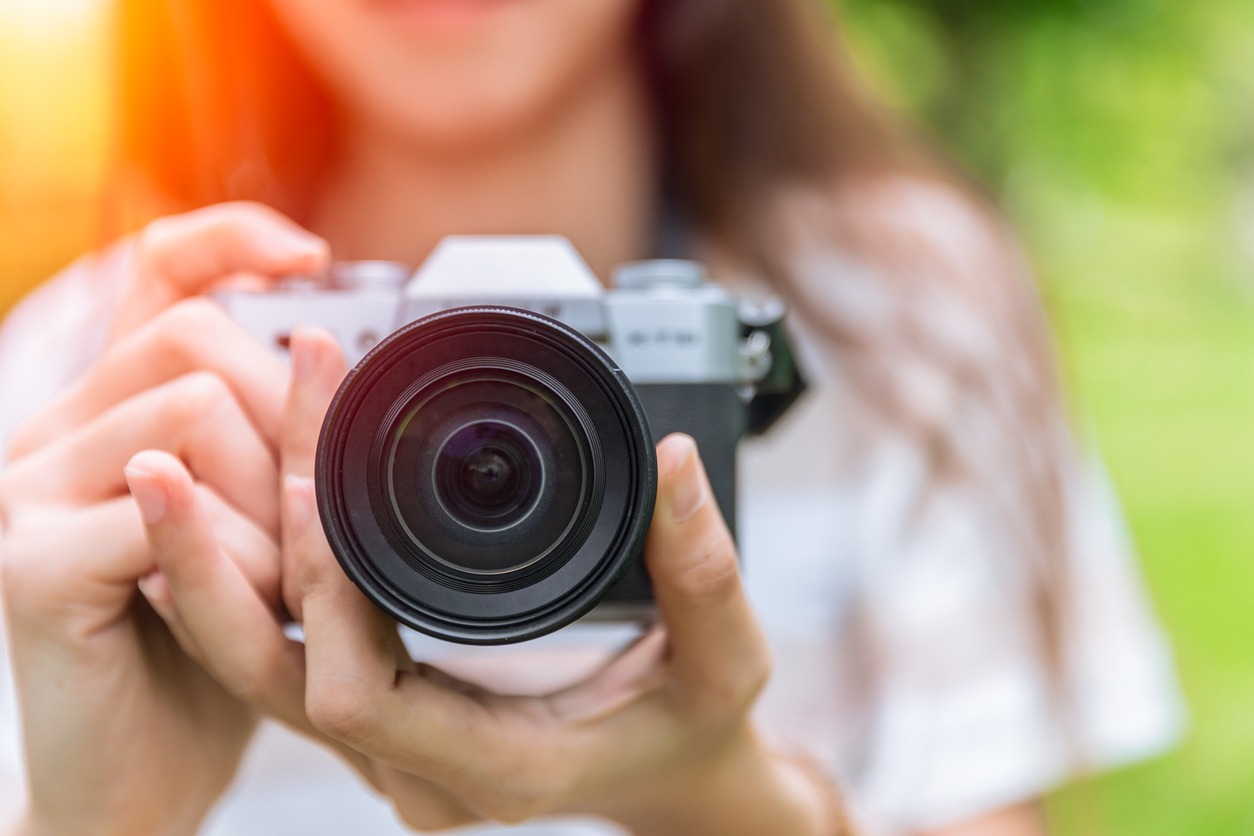Most professional photographers who used to shoot with a DSLR, are now switching to mirrorless cameras due to their features and compact size. If you are looking to get a mirrorless camera, you should have a good amount of knowledge about them to get one that suits your needs. As the name suggests, a mirrorless camera is a type of digital camera that does not have a mirror inside the camera body. Instead, it uses an electronic viewfinder to display the image that the camera’s sensor is capturing. The sensor is used to capture the image and send a live view of the image to the electronic viewfinder.
Difference Between Mirrorless Cameras And DSLR Cameras
Mirrorless cameras and DSLRs (digital single-lens reflex cameras) are both types of digital cameras, but they differ in how they capture and display an image. A DSLR uses a mirror to reflect light from the lens into the viewfinder, which allows the user to see exactly what the lens is seeing. When the picture is taken, the mirror flips up to allow light to hit the image sensor. Mirrorless cameras, on the other hand, do not use a mirror. Instead, they use an electronic viewfinder (EVF) to display the image that the lens is capturing. Because of this design, mirrorless cameras tend to be smaller, lighter, and more compact than DSLRs. If you want more information about digital cameras so that you will have a better idea on what to buy, check out our Guide to Selecting a Digital Camera.
Are Mirrorless Cameras Worth The Cost?
It comes down to what you want to use the camera for and what your budget is. If you’re a professional photographer, the advanced features of a mirrorless camera may be worth the cost. If you’re an amateur photographer or a hobbyist, a mirrorless camera might not be necessary and a DSLR or even a point-and-shoot camera may be a more cost-effective option.
The Benefits Of Mirrorless Cameras
Here are a few benefits of using mirrorless cameras.
1. Smaller and lighter form factor
Since they don’t have the mirror and prism assembly found in DSLRs, it allows mirrorless cameras to be smaller and lighter in weight. This makes them more portable and easier to carry around.
2. Faster autofocus
Mirrorless cameras use a different type of autofocus system called contrast-detection AF, which is generally faster and more accurate than the phase-detection AF used in DSLRs. This makes them better suited for tracking fast-moving subjects and capturing action shots.
3. Electronic viewfinder
An electronic viewfinder (EVF) shows a live preview of the image, rather than an optical viewfinder found in DSLRs. This allows for a more accurate representation of the final image, including exposure and white balance adjustments, and a preview of the effect of various camera settings.
4. Silent shooting
The lack of mechanical shutters found in DSLRs means mirrorless cameras can shoot silently. This is especially useful in situations where you need to be discreet, such as in wildlife photography or at events where a loud shutter noise might be disruptive.
5. Interchangeable lens
Like DSLRs, mirrorless cameras allow for the use of interchangeable lenses, giving you more creative control over your images and the ability to use different lenses for different types of photography. Although DSLRs also allow you to do the same, lenses of mirrorless cameras tend to be lighter and more compact.
6. Video capabilities
Mirrorless cameras generally have better video capabilities than DSLRs, with more advanced features such as 4K resolution and high-frame-rate recording.
Disadvantages Of Mirrorless Cameras
You may experience following disadvantages as well.
1. Battery life
Mirrorless cameras tend to have shorter battery life compared to DSLRs because the electronic viewfinder, the live preview and other advanced features consume more power.
2. Limited lens selection
While the number of available lenses for mirrorless cameras is increasing, it is still limited compared to the wide range of lenses available for DSLRs.
3. Shorter lifespan of shutter
Mirrorless cameras have a shorter lifespan shutter compared to DSLRs because the shutter mechanism is electronic rather than mechanical.
4. Limited support for older lenses
Modern mirrorless cameras often require an adapter to use older lenses, which can be expensive and may not provide full functionality, while also compromising portability.
5. Higher cost
Mirrorless cameras are generally more expensive than entry-level DSLRs, especially when you factor in the cost of additional lenses.
Getting the Most Out Of Your Mirrorless Camera
Understand your camera’s settings
Take some time to familiarize yourself with your camera’s settings and understand how they affect the final image. This includes understanding the different shooting modes, ISO, shutter speed, and manual focus. Mirrorless cameras have advanced autofocus systems, but sometimes manual focus can give you more control and result in sharper images.
Use the electronic viewfinder
The electronic viewfinder (EVF) on mirrorless cameras provides a live preview of the image and also allows you to see the effects of different settings in real-time.
Try different lenses
Mirrorless cameras are compatible with a wide range of lenses, so don’t be afraid to experiment with different lenses to see how they affect your images.
Use the touch screen
Many mirrorless cameras have a touch screen feature, which allows the user to interact with the camera by touching the screen to access different functions such as focusing, adjusting settings, and taking pictures. This feature can be very helpful in focusing as the user can simply tap on the area of the screen where they want the camera to focus, this can be useful when shooting in a fast-paced situation.
Take advantage of the silent mode
Mirrorless cameras have a silent mode that allows you to take pictures without making any noise. This can be useful in certain situations, such as when taking pictures of wildlife or in a quiet environment.
Use the built-in Wi-Fi and Bluetooth
Many mirrorless cameras have built-in Wi-Fi and Bluetooth, which allows you to easily transfer images to your phone or tablet and share them with friends and family.
Who Should Buy a Mirrorless Camera?
Street Photography: They are lightweight and compact, making them ideal for capturing candid shots on the street.
Landscape Photography: Mirrorless cameras offer high resolution and dynamic range, making them great for capturing the beauty of natural landscapes.
Portrait Photography: Features like fast autofocus and advanced skin tone detection make mirrorless cameras ideal for capturing stunning portraits.
Travel Photography: Mirrorless cameras are small and easy to pack, making them perfect for capturing your travel memories while on the go.
FAQs
What is the difference between a mirrorless camera and a point-and-shoot camera?
Point-and-shoot cameras are typically smaller and more compact, with a fixed lens and fewer manual controls. Mirrorless cameras are larger, have interchangeable lenses, and offer more advanced manual controls, making them more suitable for professional or advanced photography. Point-and-shoot cameras might be good enough for casual photography, but you need a DSLR or a mirrorless camera for professional work and or some serious photography.
How does the battery life of a mirrorless camera compare to a DSLR?
As mirrorless cameras use an electronic viewfinder and LCD screen, which consumes more power than a traditional optical viewfinder. That’s one of the reasons why their battery life is typically shorter than that of a DSLR. However, newer models have improved battery life and can last for several hundred shots on a single charge.
Are mirrorless cameras suitable for professional photography?
Yes, many professional photographers are now using mirrorless cameras for their advanced features and high image quality. They are also suitable for various types of photography such as landscape, portrait, and street.
Conclusion
Although anyone can use them, mirrorless cameras are targeted at experienced and professional photographers to extend their level of creativity. If you want to start your career in street photography, you can opt for a mirrorless camera over a DSLR because of the reasons we covered before. Plus, mirrorless cameras are more compact and lightweight than DSLRs, making them a worthy candidate for vlogging.


